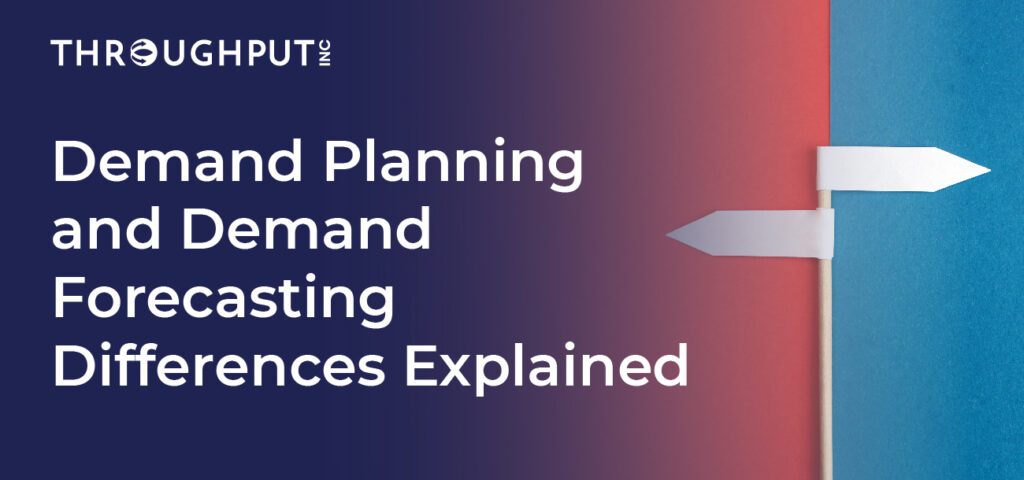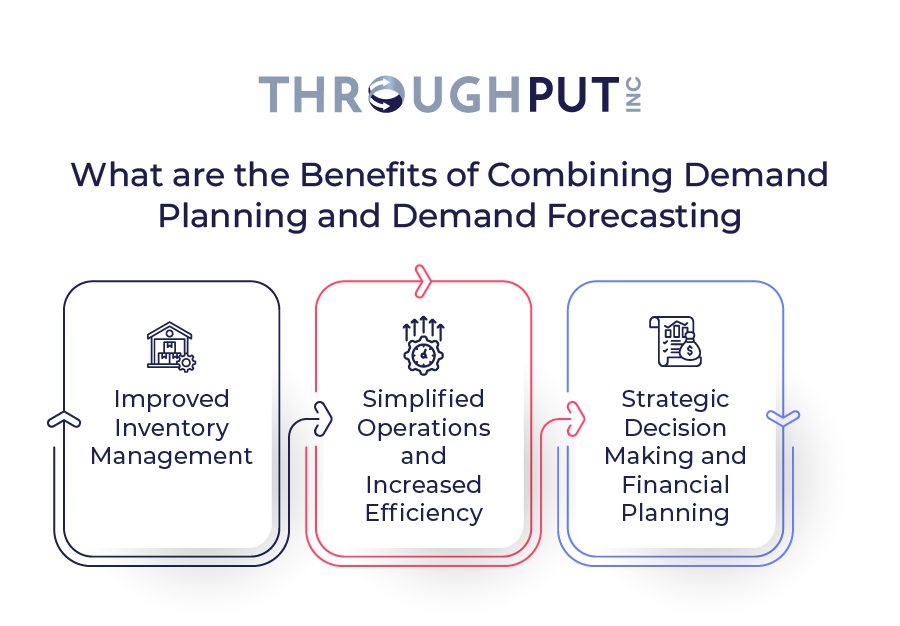Differences Between Demand Planning and Demand Forecasting

In supply chain management, accurately distinguishing between demand planning and demand forecasting is essential yet challenging. These processes are foundational for strategic supply chain management but serve distinct functions.
Misuse of these terms can lead to confusion and ineffective strategies. The consequences of conflating demand planning with demand forecasting are significant, impacting inventory management, customer satisfaction, and financial health.
Misunderstandings between the two can lead to operational inefficiencies like overstocking or stock shortages, directly affecting profitability.
This article aims to clarify the distinctions between demand planning and forecasting, highlighting how each process uniquely contributes to supply chain efficiency.
What is Demand Forecasting?
Demand forecasting is the process of predicting future customer demand for a product or service.
Think of it as a weather forecast for the market, providing a glimpse into future sales patterns based on historical data and market analysis.
The role of technology in enhancing the accuracy of demand forecasting is crucial. Modern systems leverage vast amounts of data, applying algorithms and machine learning techniques to identify trends and predict outcomes.
Historical sales data and market analysis are the backbone of creating accurate forecasts.
What is Demand Planning?
Demand planning is the strategic process that forecasts demand for products or services, aiming to synchronize inventory with market demand and optimize resource allocation.
This process is not just about numbers; it’s about the seasoned judgment and experience of professionals who interpret data and market signals to make informed decisions to manage the supply chain effectively to meet the demand.
The human element in demand planning must be balanced. It’s the expertise of individuals who, through their insights, can navigate the complexities of the supply chain.
Demand planners utilize quantitative and qualitative methods, employing advanced software and statistical models to gather insights and facilitate scenario planning.
What are the Differences Between Demand Planning and Demand Forecasting?
The difference between demand planning and demand forecasting is that they serve different roles within the supply chain. Demand forecasting focuses on the ‘what’ and ‘how much,’ while demand planning addresses the ‘how’ by integrating the forecast with business planning processes.
Demand planning is about creating a plan that meets forecasted demand and maximizes efficiency and profitability.
In contrast, demand forecasting is a more narrowly defined process that depends on predicting future demand. It serves as a critical input for demand planning but needs to encompass the broader strategic elements.
Demand planning and forecasting are not mutually exclusive; they are complementary processes that, when combined, form a powerful duo for supply chain management.
Demand Planning vs Demand Forecasting: A Quick Comparison
| Feature | Demand Forecasting | Demand Planning |
| Purpose | Predict future demand | Align operations to meet that demand |
| Scope | Analytical, data-driven | Strategic, cross-functional |
| Time Horizon | Short- to long-term | Short-term and real-time tactical decisions |
| Methods Used | Historical data, ML, regression | Forecast + human judgment + scenario planning |
| Output | Quantitative forecasts | Actionable supply chain decisions |
| Ownership | Data science / analytics team | Supply chain / operations team |
What are the Benefits of Combining Demand Planning and Demand Forecasting
The benefits of combining demand planning and demand forecasting are improved inventory management, simplified operations and increased efficiency of the supply chain.
Not to forget, the business profitability that comes from more controlled and planned supply chain operations.
The strategic advantage of integrating demand planning and forecasting lies in the synergy they create. Combining forecasting’s predictive power with demand planning’s strategic framework enables businesses to create robust, forward-looking plans grounded in reality.

1. Improved Inventory Management
One of the main advantages of combining demand planning with demand forecasting is the notable enhancement in inventory management. When demand planning utilizes the predictive insights from demand forecasting, companies can determine the ideal inventory levels with better precision.
This collaboration prevents the costly drawbacks of having excessive inventory, which can tie up funds and increase storage expenses, as well as inadequate inventory, which can result in missed sales opportunities and customer dissatisfaction.
2. Simplified Operations and Increased Efficiency
The fusion of demand planning and forecasting enables businesses to simplify their operations. With a clearer understanding of future demand, companies can schedule production runs, manage labor requirements, and coordinate logistics more efficiently, leading to improved operational efficiency.
This integration ensures that resources are allocated to where they are most needed, reducing wastage and enhancing the overall flexibility of the supply chain.
3. Strategic Decision Making and Financial Planning
Combining demand planning with forecasting also supports strategic decision making and financial planning.
Accurate forecasts provide demand planners with valuable information, enabling them to make more informed decisions regarding marketing strategies, financial investments, and resource allocation.
What are Real-life Examples of Demand Planning and Demand Forecasting?
Great real-life examples of demand planning and forecasting are Amazon, Zara and Coca-Cola.
Successful demand planning and forecasting can be seen in companies that consistently meet or exceed customer expectations while maintaining optimal inventory levels and operational efficiency.
These companies use forecasting techniques and strategic planning to respond swiftly to market changes, capitalize on opportunities, and mitigate risks.
Here’s a short breakdown of each example:
Example 1: Amazon and Demand Forecasting
Amazon operates one of the most complex supply chains in the world, dealing with millions of products and a vast customer base.
Amazon uses sophisticated demand forecasting algorithms incorporating machine learning to predict customer demand. These algorithms analyze historical sales data, customer search trends, and external factors such as seasonality and promotions.
Implementing these advanced forecasting methods has allowed Amazon to optimize its inventory levels, reduce stockouts, and improve delivery times, contributing to its reputation for fast and reliable service.
Example 2: Zara and Fast Fashion Forecasting
Zara, a fast-fashion retailer, operates in an industry where trends change rapidly, and the ability to respond quickly to consumer preferences is crucial.
Zara uses a combination of demand forecasting and demand planning to manage its supply chain. They collect data from store sales and customer feedback to forecast demand for different clothing items.
Their vertically integrated supply chain allows for quick adjustments to production based on these forecasts.
Zara’s approach has resulted in a highly responsive supply chain that can bring new designs from concept to store shelves in weeks, aligning inventory with current fashion trends and reducing markdowns.
Example 3: Coca-Cola and Demand Sensing
Coca-Cola must respond quickly to changes in consumer demand across various markets and product lines.
Coca-Cola uses demand sensing AI tools that leverage near real-time data from point-of-sale systems, social media, and weather forecasts to adjust its demand forecasts daily or weekly.
This approach has enabled Coca-Cola to be more agile in its supply chain operations, responding promptly to sudden changes in demand and minimizing waste from unsold products.
Throughput’s Approach to Demand Planning and Demand Forecasting
ThroughPut AI introduces a transformative approach to demand planning and forecasting called demand sensing by leveraging the power of artificial intelligence (AI).
Demand Sensing allows you to accurately predict customer demand in the short-term, giving you the much needed agility to respond to sudden market fluctuations.
The platform combines historical data that’s already available with other external sources of data like weather, seasonality and more to draw a more accurate picture of customer demand in the near future.
Unlike traditional demand forecasting tools, ThroughPut’s demand sensing capabilities is also combined with actionable recommendations that gives you the much-needed insights into how to plan for the forecasted demand.
Additionally, designed for quick integration with existing data streams, ThroughPut AI allows businesses to realize value in less than a fiscal quarter.
Its customizable, industry-agnostic approach minimizes barriers to implementing AI at an enterprise scale, making it a versatile tool for businesses aiming to enhance their demand planning and forecasting capabilities.
The Conclusion
Grasping the differences and how demand planning and forecasting work together is crucial for effective supply chain management.
When these processes are strategically combined, businesses can more successfully direct their operations, positioning themselves to respond adeptly to the changing market dynamics.
The adoption of AI technologies, such as those offered by Throughput AI, enhances companies’ ability to fine-tune their supply chain strategies, achieving greater precision, agility, and overall strategic foresight in their planning efforts.
FAQ:
Q1: Is demand planning possible without forecasting?
A: No. Forecasting is the input; planning is the strategic output.
Q2: What’s the biggest advantage of AI in demand forecasting?
A: Speed and accuracy — AI uses real-time data signals to adjust forecasts instantly.
Q3: How does ThroughPut.ai differ from traditional tools?
A: It combines demand sensing, planning, and execution insights in one real-time, no-integration platform.

